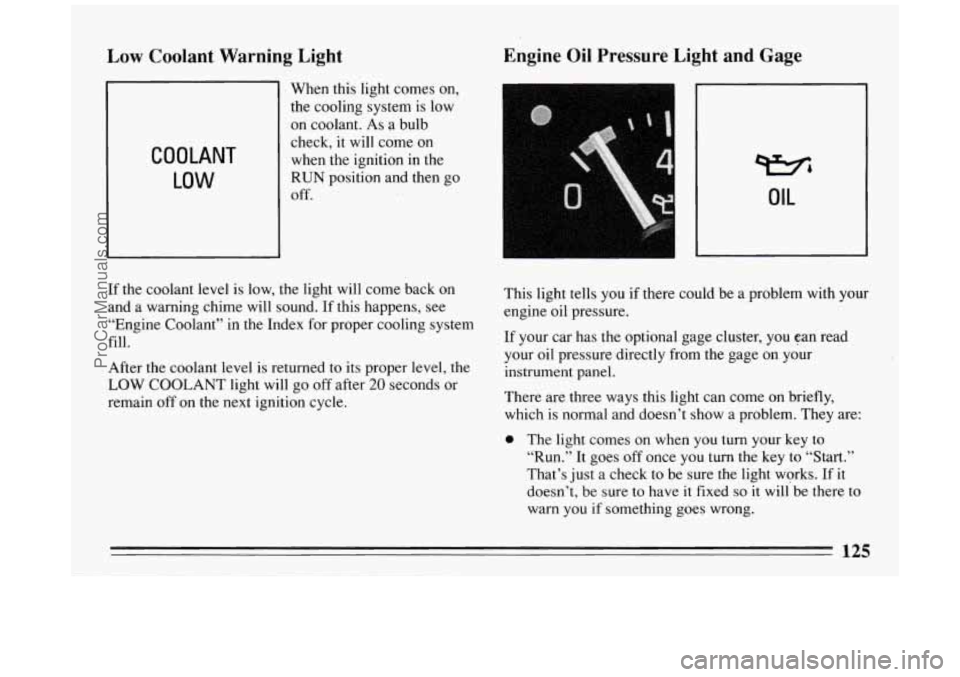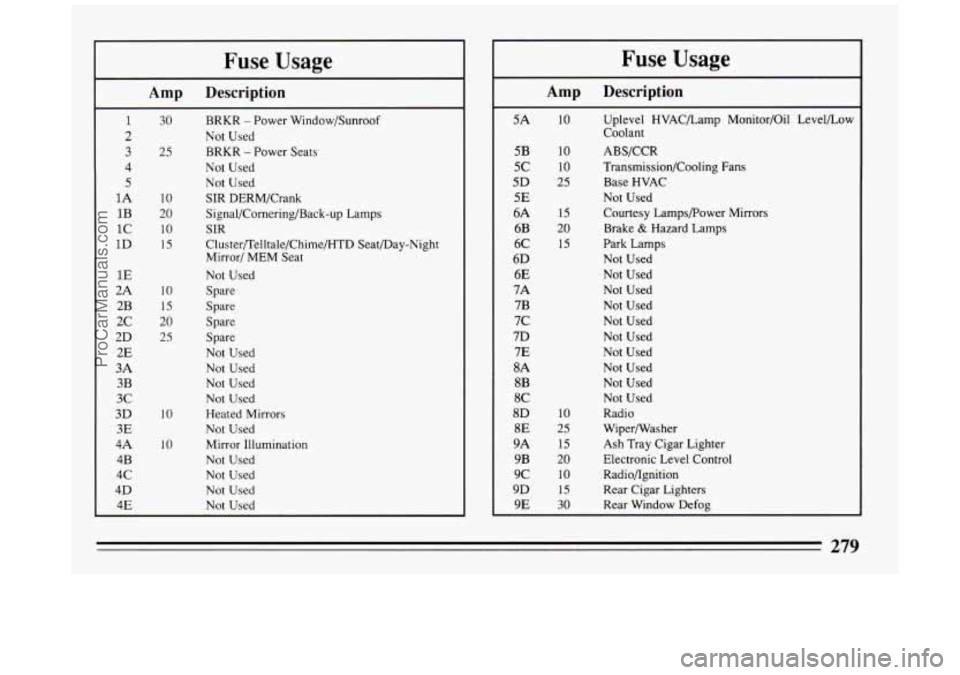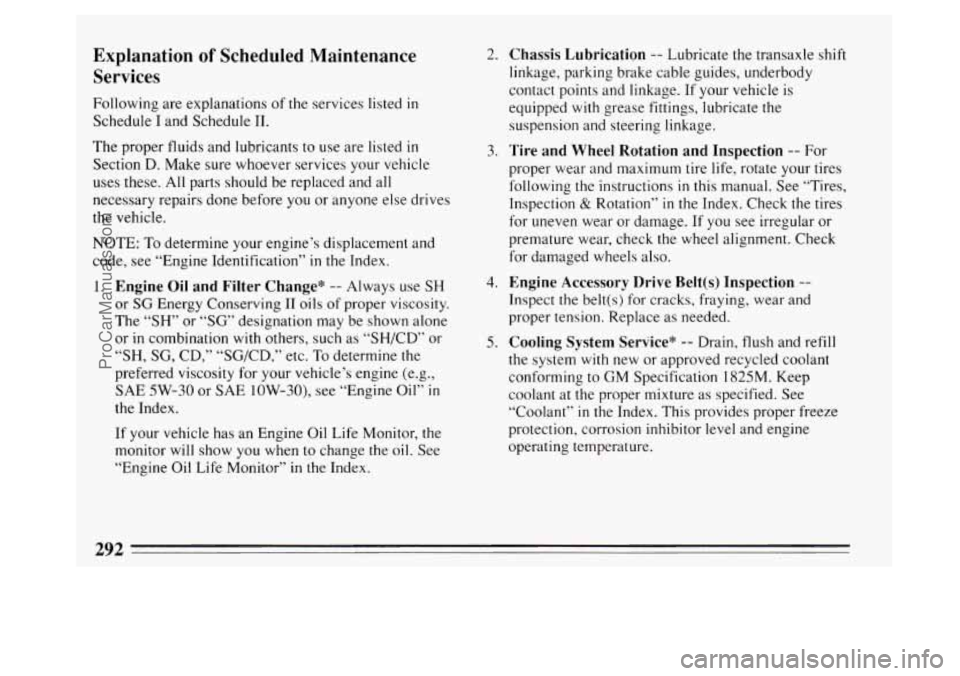Page 127 of 324

Low Coolant Warning Light Engine
Oil Pressure Light and Gage
COOLANT
LOW
When this light comes on,
the cooling system is low
on coolant. As a bulb
check, it will come on
when the ignition in the
RUN position and then go
Off.
Wb
OIL
If the coolant level is low, the light will come back on
and
a warning chime will sound. If this happens, see
“Engine Coolant’’ in the Index for proper cooling system
fill.
After the coolant level is returned to its proper level, the
LOW COOLANT light will go off after 20 seconds or
remain off
on the next ignition cycle. This
light
tells you if there could be a problem with your
engine oil pressure.
If your car has the optional gage cluster, you can read
your oil pressure directly from the gage on your
instrument panel.
There are three ways this light can come on briefly,
which
is normal and doesn’t show a problem. They are:
0 The light comes on when you turn your key to
“Run.”
It goes off once you turn the key to “Start.”
That’s just a check
to be sure the light works. If it
doesn’t, be sure
to have it fixed so it willbe there to
warn you if something goes wrong.
125
ProCarManuals.com
Page 211 of 324
If the coolant inside the coolant recovery tank is boiling,
don’t do anything else
until it cools down.
P
The coolant level should be at or above “FULL COLD.”
If it isn’t, you may have a leak in the radiator hoses,
heater hoses, radiator, water pump or somewhere else in
the cooling system.
I NOTICE:
I
Engine damage from running your engine
without coolant isn’t covered
by your warranty.
If there seems to be no leak, check to see if the electric
engine fans are running.
If the engine is overheating,
both
fans should be running. If they aren’t, your vehicle
needs service.
209
ProCarManuals.com
Page 212 of 324
How to Add Coolant to the Coolant
Recovery Tank
If you haven’t found a problem yet, but the coolant level
isn’t at or above the
“FULL COLD” mark, add a 50/50
mixture of clean water (preferably distilled) and a
proper antifreeze at the coolant recovery tank. (See
“Engine Coolant’’
in the Index for more information
about the proper coolant mix.)
NOTICE:
In cold weather, water can freeze and crack the
engine, radiator, heater core and other parts. Use
the recommended coolant.
210
ProCarManuals.com
Page 215 of 324
4. Then fill the coolant recovery tank to “FULL COLD.”
5. Put the cap back on the coolant recovery tank, but
leave the radiator pressure cap off.
6. Start the engine and
let it run
until you
can feel the upper
radiator hose
getting hot. Watch
out for the engine
fans.
7. By this time the coolant level inside the radiator
filler neck may be lower. If the level
is lower, add
more of the proper mix through the filler neck until
the level reaches the base of the filler neck.
ProCarManuals.com
Page 229 of 324

Part 6 Service and Appearance Care
Here you will find information about the care of your Buick . This part begins with service and fuel information. and
then
it shows how to check important fluid and lubricant levels . There is also technical information about your
vehicle. and a section devoted to its appearance care
.
Part 6 includes:
Service ........................................................................\
.. 228
Fuel
........................................................................\
..... 229
HoodRelease
..................................................................... 234
Engineoil
....................................................................... \
238
Aircleaner
....................................................................... \
243
Automatic Transaxle Fluid
........................................................... 244
Enginecoolant
.................................................................... 247
PowerSteeringFluid ............................................................... 250
Windshield Washer Fluid
............................................................ 251
Brakes
........................................................................\
... 252
Battery
........................................................................\
.. 255
BulbReplacement
................................................................. 256
Loading Your Vehicle
............................................................... 258
Tires
........................................................................\
.... 260
Appearancecare
.................................................................. 268
Vehicle Identification Number (VIN) .................................................. 276
FusesandCircuitBreakers
........................................................... 277
Capacities and Specifications
......................................................... 282
227
ProCarManuals.com
Page 250 of 324
Adding Coolant
The coolant recovery tank is located at the left of the
engine compartment.
To Check Coolant
When your engine is cold, the coolant level should be at
“FULL COLD’ or a little higher. When your engine is
warm, the level should be up to
“FULL HOT” or a little
higher.
COOLANT
LOW
If this light comes on, it means you’re low on engine
coolant.
To Add Coolant
If you need more coolant, add the proper mix at the
coolant recovery tank.
248
ProCarManuals.com
Page 281 of 324

Fuse Usage
Amp Description
1
2
3
4
5
1A
1B
1c
1D
1E
2A
2B
2c
2D 2E
3A 3B
3c
3D 3E
4A 4B
4c
4D
4E
10
20
10
30 BRKR - Power Window/Sunroof
25 BRKR
- Power Seats
Not Used
Not Used
Not Used
SIR DERM/Crank
Signal/Cornering/Back-up Lamps
SIR
15
10
15
20
25
10
10
:ht Cluster/Telltale/Chime/HTD Seat/Day-Nig
Mirror/ MEM Seat
Not Used
Spare
Spare
Spare
Spare
Not Used
Not Used
Not Used
Not Used
Heated Mirrors
Not Used
Mirror Illumination
Not Used
Not Used
Not Used
Not Used
Amp Description
5A
5B
5c
5D 5E
6A
6B
6C
6D
6E
7A
7B
7c
7D
7E
8A 8B
8C
8D
8E
9A
9B
9c
9D
9E
10
10
10
25
15
20
15
10
25
15
20
10
15
30
Uplevel HVAC/Lamp Monitor/Oil Level/Low
Coolant
ABS/CCR
Transmission/Cooling Fans
Base HVAC
Not Used
Courtesy Lamps/Power Mirrors
Brake
& Hazard Lamps
Park Lamps
Not Used
Not Used
Not Used Not Used
Not Used
Not Used Not Used
Not Used
Not Used
Not Used Radio
Wipermasher
Ash Tray Cigar Lighter
Electronic Level Control
Radiohgnition
Rear Cigar Lighters
Rear Window Defog
279
ProCarManuals.com
Page 294 of 324

Explanation of Scheduled Maintenance
Services
Following are explanations of the services listed in
Schedule I and Schedule 11.
The proper fluids and lubricants to use are listed
in
Section D. Make sure whoever services your vehicle
uses these. All parts should be replaced and all
necessary repairs done before you or anyone else drives
the vehicle.
NOTE: To determine your engine’s displacement and
code, see “Engine Identification”
in the Index.
1. Engine Oil and Filter Change* -- Always use SH
or SG Energy Conserving I1 oils of proper viscosity.
The
“SH” or “SG” designation may be shown alone
or
in combination with others, such as “SH/CD” or
“SH,
SG, CD,” “SG/CD,” etc. To determine the
preferred viscosity for your vehicle’s engine (e.g., SAE
5W-30 or SAE low-30), see “Engine Oil” in
the Index.
If your vehicle has an Engine Oil Life Monitor, the
monitor will show you when to change the oil. See
“Engine Oil Life Monitor”
in the Index. 2.
Chassis Lubrication -- Lubricate
the transaxle shift
linkage, parking brake cable guides, underbody
contact points and linkage. If your vehicle is
equipped
with grease fittings, lubricate the
suspension and steering linkage.
3. Tire and Wheel Rotation and Inspection -- For
proper wear and maximum tire life, rotate your tires
following the instructions
in this manual. See “Tires,
Inspection
& Rotation” in the Index. Check the tires
for uneven wear or damage. If you see irregular or
premature wear, check the wheel alignment. Check
for damaged wheels also.
4. Engine Accessory Drive Belt(s) Inspection --
Inspect the belt(s) for cracks, fraying, wear and
proper tension. Replace as needed.
5. Cooling System Service* -- Drain, flush and refill
the system
with new or approved recycled coolant
conforming to GM Specification 1825M. Keep
coolant at the proper mixture as specified. See
“Coolant”
in the Index. This provides proper freeze
protection, corrosion inhibitor level and engine
operating temperature.
292
ProCarManuals.com